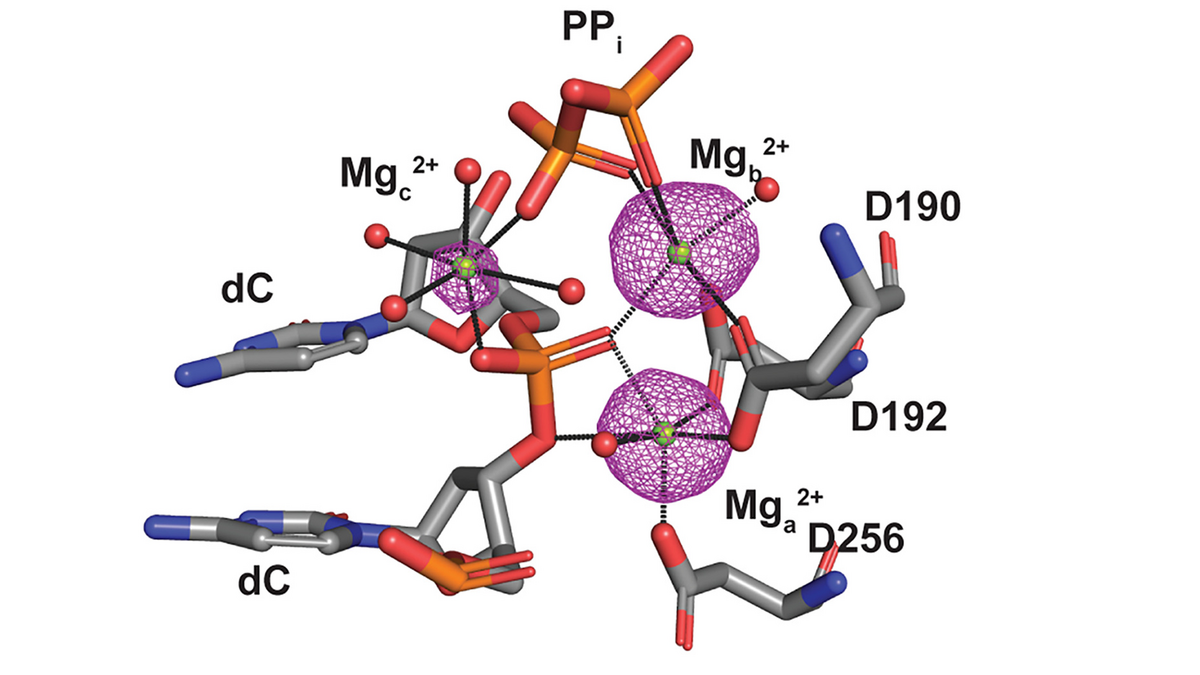DNA repair research has applications in disease and cancer treatments

Model of DNA polymerase beta active site.
DNA provides instructions that allow organisms to reproduce, adapt and grow, including when the organism is injured in some way. When an organism’s DNA itself is damaged, cells contain repair enzymes that can repair the DNA. One of these repair enzymes, found in eukaryotic cells (cells that have a nucleus) is DNA polymerase beta.
The importance of this polymerase is seen in that the absence of a properly functioning enzyme in humans is associated with neurodegeneration, and exacerbates Alzheimer’s disease. Understanding the structure and function of DNA polymerase beta provides insight into not only treatment of diseases, but also in cancer therapies.
Sidney Hecht, a professor in the School of Molecular Sciences and director of the Center for Bioenergetics in the Biodesign Institute at Arizona State University, together with Sasha Daskalova from ASU and researchers from Florida State University College of Medicine and The Ohio State University, studied the series of molecular steps involved in base excision repair, a type of DNA repair in which DNA polymerase beta is involved.
Their paper, "Interlocking activities of DNA polymerase β in the base excision repair pathway," is published in The Proceedings of the National Academy of Sciences, one of the most-cited scientific journals in the world. The study described in the article provides insight into the detailed reaction mechanism of DNA repair by DNA polymerase beta and facilitates a deeper understanding of an important physiological process.
The insights from this study might be of utility in correcting/compensating for molecular defects in DNA polymerase beta in some individuals.
“This study has provided important insights into an unusual mechanistic element of DNA repair by human DNA polymerase beta," Hecht said. "This enzyme is unusual in that it has two active sites within a single peptide chain. The temporal coordination of the activities of these two sites may well be the reason that both active sites are present in the same peptide chain.”
Human DNA polymerase beta is of practical interest because it repairs the damage done to the DNA in cancer cells after individuals with cancer are treated with DNA-damaging agents for chemotherapy. Plausibly, adjuvant cancer therapy might include an inhibitor of DNA polymerase beta to be co-administered with the therapeutically relevant DNA-damaging agent.
This study could also facilitate the design of improved DNA polymerase beta inhibitors for the adjuvant chemotherapy of cancers. Hecht, who played a key role in the development of Hycamtin, a drug used to treat ovarian and lung cancer, continues to research the role of DNA polymerase beta in human health.
More Science and technology

ASU researcher part of team discovering ways to fight drug-resistant bacteria
A new study published in the Science Advances journal featuring Arizona State University researchers has found…

ASU student researchers get early, hands-on experience in engineering research
Using computer science to aid endangered species reintroduction, enhance software engineering education and improve semiconductor…

ASU professor honored with prestigious award for being a cybersecurity trailblazer
At first, he thought it was a drill.On Sept. 11, 2001, Gail-Joon Ahn sat in a conference room in Fort Meade, Maryland.…